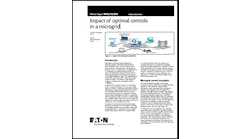S&C Electric’s Erik Svanholm discusses the potential of microgrids as non-wires alternatives, which use distributed energy resources and microgrids to defer or replace the installation of more traditional ‘wires and poles’ infrastructure.
Erik Svanholm, vice president, non-wires alternatives for S&C Electric
Non-wires alternatives (NWAs) are any nontraditional investments that allow electric utilities to defer or avoid upgrading existing electrical infrastructure (or “wires”) while providing electric utilities and commercial and industrial (C&I) enterprises with new, cost-effective ways to address evolving grid challenges. These investments either reduce electrical loads or increase energy production at a specific location. Over the past year, NWAs, and microgrids in particular, have become strategic considerations for energy stakeholders on both sides of the electric utility meter.
Distribution utilities, commercial power users, and energy project investors are all navigating the unique challenges and opportunities associated with combining proven technologies to create cost-effective new solutions at the grid edge. Many are looking to microgrids as a cornerstone of the 21st century electrical grid.
Among distribution utilities, capacity constraints and reliability concerns at specific points on the grid edge are becoming more expensive and logistically challenging to address using the traditional methods of expanding or adding new substations or reconductoring power lines. Many utilities have substations originally built decades ago with ample capacity and vacant surrounding land. These same substations are now strained suburban or urban sites with buildings on all sides.
Faced with such a situation, utilities face a challenge: How do they conduct major equipment upgrades on confined lots without extensive customer disruptions? If a feeder coming into the substation is also capacity-constrained and must be upgraded, the utility faces the same type of problem winding through miles of cityscape. Both scenarios present daunting engineering and construction challenges and spur consideration of non-traditional solutions. These include adding distributed energy resources at the substation site and implementing controls for autonomous operation to further enhance resiliency.
Unfortunately, the rural countryside provides little relief for utility planners. Those areas lack the infrastructure redundancy found in most urban areas, and throughout the country, long, rural feeders are the only power source for many major industrial facilities in small towns, and for the towns themselves. Outages can be frequent and prolonged, causing major disruptions to the local economy. Traditional solutions for this scenario include building redundant feeder ties or upgrading the single line. Unfortunately, both options may be prohibitively expensive or difficult to implement without creating an excessive inconvenience to customers. Because they can be built at a specific location without severely disrupting utility infrastructure, microgrids may be an effective non-wires solution in these circumstances, sparing rural communities and businesses from the risk of service outages.
On the other side of the utility meter, power users are growing increasingly reliant on uninterrupted power, and the consequential cost of grid disruptions continues to rise. One industry where these rapid changes are occurring is retail distribution. Not long ago, transfer of goods in warehouses was done manually, with forklifts and human labor. Today, operations are automated, with facility roofs covering crisscrossing automated conveyors, all controlled by barcode scanners and backed by vast databases. In this environment, even momentary power outages trigger complete system reboots taking at least an hour. These production stoppages mean longer delivery times to retail customers, creating lasting damage in an industry where margins are thin, and competition is ferocious.
Non-wires alternatives (NWAs) are any nontraditional investments that allow electric utilities to defer or avoid upgrading existing electrical infrastructure (or “wires”) while providing electric utilities and commercial and industrial (C&I) enterprises with new, cost-effective ways to address evolving grid challenges.
Today, common grid-edge facilities, such as agricultural and industrial processing plants, factories, and distribution hubs,cannot tolerate utility outages of virtually any duration. These commercial and industrial operators are starting to take matters into their own hands by investing in NWAs taking the form of financially viable, resilient, and islandable microgrids that can provide the continuous power they need.
Resilient, distributed energy solutions have arrived just in time. After a decade of experiments and pilot projects, microgrids have established themselves as technically feasible NWAs. Big questions remain, however, for the prospective beneficiaries of these non-traditional solutions:
- Where should I turn for help?
- How can I ensure a microgrid built today will continue to perform many years from now?
- How can I afford an advanced microgrid dedicated to my unique needs?
Anyone interested in using microgrids as NWAs should be looking for contributors with broad demonstrable experience in the microgrid technology space. This includes electrical, environmental, and regulatory design considerations as well as applied technology, such as distributed energy resources, switchgear, and controls. But there are other factors equally critical to consider when looking for solution providers.
The first of these is the staying power of prospective solution providers, both backward-looking and forward-looking. Backward-looking staying power is another way of saying proven operational history. Utilities and industrial companies lament seeing a variety of potentially compelling new technologies—especially software—emerging from small start-ups because they find it difficult to rely on innovations from young companies to support their critical infrastructure.
Forward-looking staying power means the likelihood a microgrid supplier will remain a player in the market for years to come. This is important because the operational life of microgrids is measured in multiple decades. The long-term viability of newer, small companies is one clear risk, but even multinational conglomerates are undergoing major transitions in their energy businesses. As a result, microgrid buyers of all kinds feel the need to scrutinize the long-term industry commitment of prospective suppliers.
Expectations of long supplier endurance are important for another reason: financing. Financing in the form of long-term power purchase agreements greatly accelerated the growth of the wind and solar industries over the past few decades, and the same will likely be true for microgrids. For most commercial organizations, it is easier to commit to long-term payment streams than to major direct capital investments. Financial markets are awash in capital eager for deployment toward long-term energy projects, but those investments must be deemed predictable and safe over the whole investment horizon. Projects backed by technology suppliers and services providers with strong forward-looking staying power will have a much easier time securing funding.
NWAs are quickly moving from conceptual frameworks to specific opportunities as utilities and commercial operators unlock the potential of microgrid technology designed, deployed, and maintained by a steadfast provider. The next exciting phase of this evolution is here, with cutting-edge microgrids leading the way in solving today’s grid-edge challenges.
Erik Svanholm is vice president of non-wires alternatives at S&C Electric and president of its microgrid controls subsidiary, IPERC.








